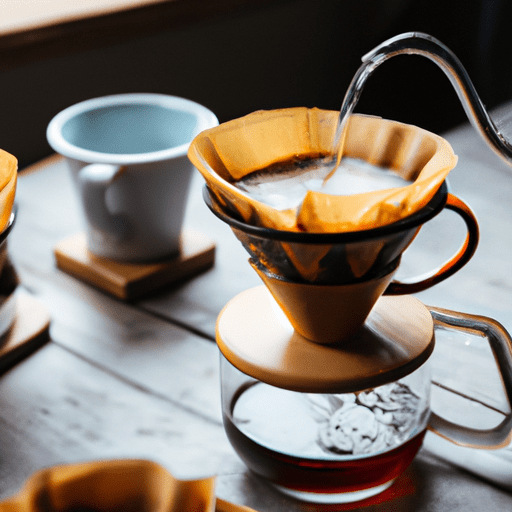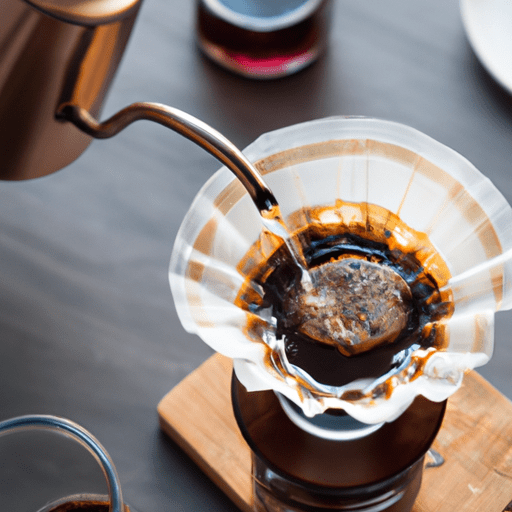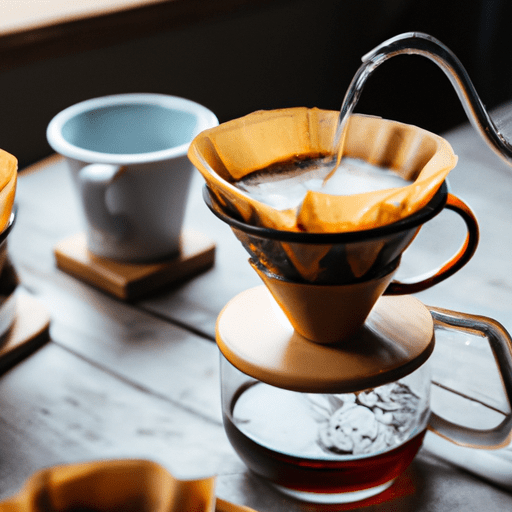Brimming with joy, you’re about to embark on a fascinating journey to master the art of making pour over coffee without a scale. This perfect brewing method promises to elevate your coffee experience, revealing intense tastes and flavors that could make a barista green with envy! Lively, bold, or robust – whatever your preference may be, the pour over method brings out the best in your beans. Allowing for precision and control, art and science beautifully converge in this process, and this treasure trove of trade secrets will equip you with unique ways of brewing delicious pour over coffee – sans the scale. Now, just picture that glorious aroma wafting through your kitchen every morning, what a delightful way to start your day!

Essential Equipment for Pour Over Coffee without a Scale
The art of making pour over coffee is an enjoyable process that can yield rich, complex, and delicious results. While many coffee aficionados have a scale at their disposal, you don’t need one to make fantastic pour over coffee. Understanding the necessary equipment and how to use it is the first step in your journey towards coffee mastery.
Choosing the Right Coffee Beans
Your pour over coffee is only as good as your beans. Choose high-quality, freshly roasted coffee beans. Look for a roast that appeals to you; a medium roast is often ideal for pour over coffee, but there’s no harm in experimenting! From the nutty, chocolate notes of a Brazilian roast to the fruity undertones of an Ethiopian blend, each variety will bring unique flavors to your brew.
Grinder Selection and Settings
A good grinder is key to creating the perfect grounds for your pour over coffee. Burr grinders, which crush the beans between two abrasive surfaces, are preferable to blade grinders, as they produce a much more consistent grind. You’ll also want to adjust your grinder to a medium-coarse setting.
Pour Over Coffee Dripper
The dripper is what you’ll place atop your cup or carafe, into which you’ll put your coffee grounds and water. There are many fantastic drippers to choose from. Whichever you pick, be sure to pre-wet the filter to remove any papery taste before adding your coffee grounds.
Kettle and Thermometer
Next, you’ll need a kettle with a long, thin spout for precise pouring. These are often called gooseneck kettles. A thermometer is also valuable so you can make sure your water is at the optimal brewing temperature.
Understanding Coffee-to-Water Ratio
Why Ratio Matters
When brewing coffee, the ratio of coffee grounds to water is crucial. It influences the strength and flavor of your brew. If too few grounds are used, your coffee might be watery or lack flavour. If too many are used, your coffee could end up too strong or bitter.
Common Ratio Recommendations
A standard recommendation for the coffee-to-water ratio is 1:17, which means one part coffee to 17 parts water. However, if you don’t have a scale, you can use everyday tools like tablespoons and volume cups as substitutes.
Adjusting Ratio for Personal Preference
The 1:17 ratio may provide a good starting point, but feel free to adjust the ratio according to your taste preference. If you prefer a stronger brew, use more coffee. If a lighter brew suits you best, use less.
Measuring Coffee and Water without a Scale
Using Tablespoons for Coffee
While it’s not as precise as a scale, a tablespoon can be a good tool to measure coffee. Typically, one level tablespoon of ground coffee is approximately 5 grams.
Converting Tablespoons to Grams
To achieve your desired ratio, you can convert tablespoons to grams by keeping in mind that one tablespoon of coffee is about equivalent to 5 grams. For a 300 millilitre cup of coffee (roughly 10.6 ounces) using a 1:17 ratio, you would use about two level tablespoons.
Measuring Water with Volume Cups
You can use standard size volume cups or any cup with known volume to measure water. Just remember your ratio: for every 5 grams (one tablespoon) of coffee you’ve added, you’ll need 85 millilitres of water.

Grinding Coffee Beans for Pour Over
Understanding Grind Size
Grind size impacts the taste of your pour over coffee in a big way. A finer grind will result in a stronger brew, whereas a coarser grind will give a lighter, less strong cup of coffee.
Finding the Right Grind Size
The optimal grind size for pour over coffee is typically described as medium-coarse, similar to sea salt. It might require a little experimenting to dial in the perfect grind for your specific coffee and equipment.
Using Visual Cues for Consistency
Visual cues are essential when grinding coffee without a scale. Pay attention to ensure the grounds are similar in size and there aren’t too many boulders or fines, as this could lead to inconsistent extraction.
Water Temperature and Its Impact on Pour Over Coffee
Optimal Water Temperature Range
Water temperature plays a significant role in making great coffee. The best temperature range is generally 195 to 205 degrees Fahrenheit (or 90 to 96 degrees Celsius). Too cool, and your coffee can turn out weak and underextracted. Too hot, and it can overextract and become bitter.
Using a Thermometer or Electric Kettle
If you’re unsure about your water temperature, using a thermometer could be a great help. Some kettles even come with a built-in thermometer, or you might consider using an electric kettle with temperature control.
Factors Affecting Water Temperature
Keep in mind that pouring water from a height can cool it down. To maintain the optimal brewing temperature, make sure the kettle is close to the dripper when you start to pour.
Pouring Technique for Pour Over Coffee
The Importance of Proper Pouring
Proper pouring technique is critical to ensuring a balanced extraction. The goal is to evenly saturate the coffee grounds with water.
Achieving a Steady and Controlled Pour
Use a slow, steady, and controlled pour, starting at the middle and circling outwards, avoiding pouring directly onto the filter.
Managing Flow Rate
Avoid pouring all the water into the dripper at once. Instead, aim to keep the water level consistent by adding a bit of water every 10-15 seconds.
Brewing Time and Extraction
Understanding Extraction in Pour Over
Extraction refers to how much flavor you’re pulling from the coffee grounds. The total brew time, grind size and water temperature are the main factors affecting extraction.
Determining Brew Time without a Scale
Typically, the total brew time for pour over coffee is somewhere between 2.5 to 3.5 minutes, including the initial 30 seconds that the coffee spends blooming (or degassing).
Adjusting Brew Time for Flavor
If your coffee tastes too bitter, you might be over-extracting it, and you should try to decrease your brewing time. If it’s weak or sour, try increasing your brewing time to extract more flavor from the grounds.
Troubleshooting Common Issues
Over-extracted Coffee
Over-extracted coffee can taste bitter and lacks its own character. To avoid over-extraction, use slightly larger coffee grinds, brew with cooler water, or reduce your brew time.
Under-extracted Coffee
If your coffee is under-extracted, it may taste sour or weak. To resolve this, try a finer grind size, hotter water or a longer brew time.
Uneven Extraction
Uneven extraction often results in a mix of over and under-extracted coffee. It tastes both sour and bitter. To prevent this, ensure your coffee grounds are evenly saturated when pouring.
Fine-tuning Your Pour Over Technique
Experimenting with Variables
If you’re not satisfied with your first few attempts, don’t worry. Coffee brewing is all about personal taste. Experiment with grind size, water temperature, and coffee-to-water ratios to find your perfect brew.
Noting Tasting Notes and Adjustments
Writing down your observations regarding taste will guide your adjustments. Make a note of your tasting notes and the changes you’ve made while brewing. This way, you can look back and understand what worked best for you.
Continuous Practice and Improvement
Consistency is key when it comes to brewing pour over. Keep practicing your technique, as well as your ability to discern different flavors and nuances in the coffee.
Final Thoughts and Recommendations
Embrace the Art of Improvisation
Remember, coffee making, especially pour over coffee, is an art. Embrace the improvisation and the creativity it allows. Use this guide as a starting point and experiment to find your perfect cup.
Don’t Be Afraid to Make Mistakes
There’s a lot to learn and many variables to manage, so don’t be disheartened if your first batch doesn’t turn out perfect. Learn from each brew, make adjustments, and strive to improve.
Share Your Discoveries with Others
Finally, share your newfound coffee knowledge with others. After all, coffee is a social beverage, best enjoyed with good company. Make a pot, share your findings, and most importantly, enjoy the process.
